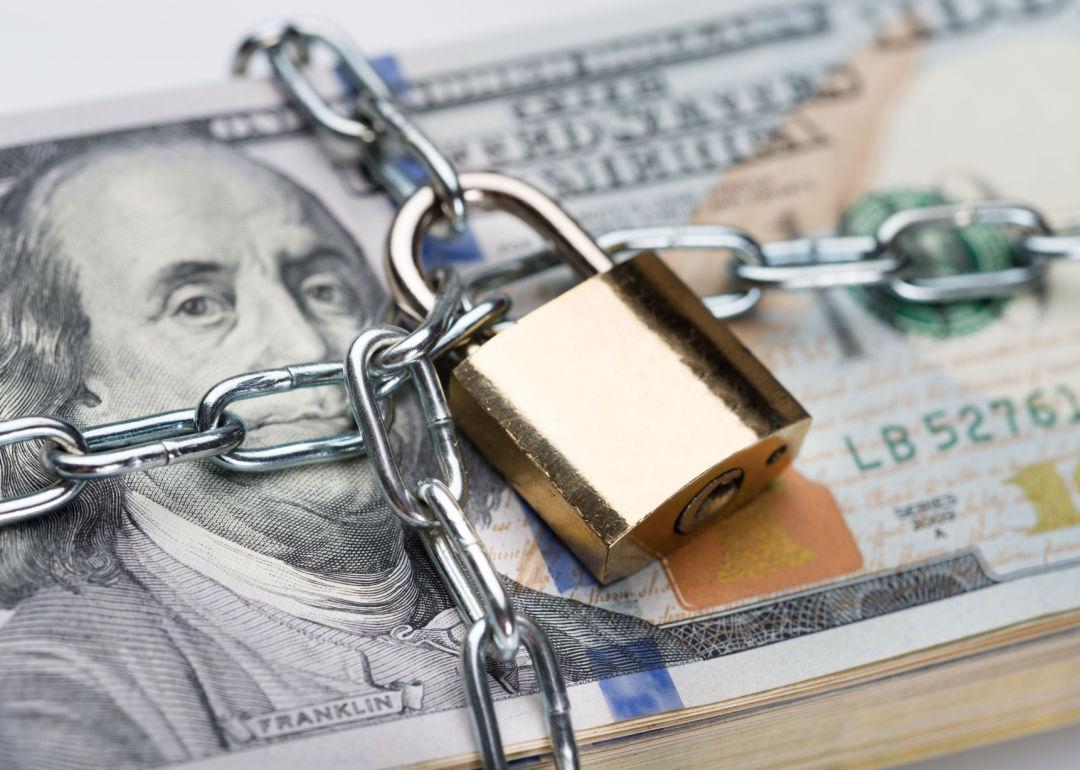CD balances shot up by nearly $400 billion in 9 months—here's why

Andrey_Popov // Shutterstock
CD balances shot up by nearly $400 billion in 9 months—here’s why
A padlock locks chain around a stack of $100 dollar bills
In a financial landscape where every money move seems a little more risky than it did yesterday, Americans are flocking towards bank certificates of deposit as a safe place to store their cash.
As the U.S. economy grapples with inflation, rising interest rates, and multiple bank failures, CDs have quietly shaken off their humdrum reputation and enjoyed a surge in popularity.
Balances in CDs shot up from $36.5 billion in April 2022 to $418.4 billion in January 2023, according to the Federal Reserve cited by the Wall Street Journal. That’s a 1,046% increase, or a jump of almost $400 billion, in just nine months.
To better understand where you can also build your wealth, Moneywise looks at why CDs are so attractive right now, plus explores two other safe havens for your money.
CDs are a solid investment
A CD is a time-deposit account where you stash a sum of money for a set term — generally ranging from 30 days to five years — and the bank agrees to pay a fixed interest rate, which is typically higher than what you would earn from a basic savings account.
Offered by most banks and credit unions, CDs are a hot commodity right now because of how they respond to general economic conditions.
There are a number of variables that affect the direction of CD rates, including the Federal Reserve’s baseline, bank profits, changes in treasury yields and economic conditions. This year, inflation and a potential recession are pushing CD rates up.
According to the Federal Deposit Insurance Corporation (FDIC), the average annual percentage yield (APY) on one-year CDs was 1.54% as of April 17, 2023. Meanwhile, the average return on a five-year CD was 1.37%.
It is possible to find CD rates that are well above the average. As of May 8, Alliant was offering a 5% yield for a 1-year term, while Synchrony was offering a 4.75% yield over the same term.
The ability to lock in and guarantee a return on your investment is an attractive idea. For instance, if you put your money into a five-year CD, you’ll get the same rate through those five years, even if the Fed cuts interest rates during that period.
![]()

Canva
CDs are a safe place to store your money
A young couple reviews financial documents together.
CDs are generally seen as a safe place to keep cash — a top priority for Americans after the collapse of Silicon Valley Bank, Signature Bank, and First Republic Bank.
When announcing the latest interest rate hike in May, the Fed said the “U.S. banking system is sound and resilient” but that current conditions — including the bank collapses — are likely “to weigh on economic activity, hiring and inflation.”
Central banks are also making every effort to bolster confidence in the U.S. banking system, but many Americans have been left questioning whether their money is safe.
CDs are one of the lowest risk investment tools you can use.
You can put up to $250,000 in CDs and won’t lose that money as long as your account is with a bank insured by Federal Deposit Insurance Corporation (FDIC) or a credit union insured by the National Credit Union Administration (NCUA).
The only way you’ll lose money is if you try to withdraw your money before the end of your CD term. If you do that, you’ll have to pay a penalty which is usually around three to six months of interest.
You should only use CDs if you’re comfortable locking away a sum of money for a set period of time. Most people use them for short-term goals, like saving for college or for a deposit on a house.
It’s important to stay on top of your CD term. Your bank will likely tell you when it’s about to expire and will give you the option of cashing out or negotiating a new CD.
If you do nothing, your money could automatically roll over into a new CD with the same term, but potentially at a different rate than your previous one. This could work in your favor if you don’t need your money immediately, or it could leave you cash strapped and in line for a penalty if you need to withdraw your money early.
While CDs are a secure haven for your savings, they don’t always offer the most attractive returns. Here are two other low-risk ways to meet your saving goals and build your wealth.

Canva
Alternatives to investing in CDs
Woman sits at a desk reviewing financial charts.
Buy series I savings bonds
Series I savings bonds are safe investments issued by the U.S. Treasury, which are designed to protect the value of your hard-earned cash from inflation.
Interest rates on I bonds are adjusted every six months to keep pace with rising prices. The next change is due on Nov. 1.
The current interest rate on I bonds is 4.3% — down from the 9.62% rate in the six months to October 2022, but still a very attractive yield when compared to the average CD rates of 1-2%.
I bonds are a good compound saving tool. Twice a year, the interest you earned in the past six months will be added to your total bond value and you’ll start earning interest (at a new rate) on that higher value.
You can get I bonds in a few different ways. You can buy up to $10,000 worth of electronic I bonds through the government’s TreasuryDirect website and you can also buy up to $5,000 in paper I bonds with your IRS tax refund. The maximum amount you can buy each year is $15,000.
I bonds last for 30 years, but you don’t need to wait three decades to cash in.
Be aware that your money is locked in for one year. After that, if you cash in your bond in less than five years, you’ll have to forfeit three months of interest. There are no further penalties for withdrawal after five years.
As a U.S. Treasury security, I bonds have a very low risk of default. They also offer attractive tax benefits as they’re exempt from state and municipal income taxes.
You do have to pay federal income tax, but there are some exemptions. For instance, if you use the money for qualified higher education expenses, you may not have to pay tax on the earnings.
Make the most of your IRA
While CDs are typically used for short-term savings goals, an individual retirement account (IRA) can help you to save and build your wealth over decades — but you will have to put your money to work.
A traditional IRA is a pre-tax investment account.
You make contributions from your income before taxes are taken out, and the money grows tax-free until you withdraw it in retirement — when you’ll likely find yourself in a much lower tax bracket than in your working years.
In contrast, a Roth IRA is funded with money that’s already been taxed, which means your withdrawals in later life will be tax free.
Unlike CDs, I bonds, and the traditional IRA — which either have maturity dates or mandatory withdrawals — you can leave your money untouched in a Roth IRA for as long as you’d like, making it one of the most flexible options out there for retirement savers.
You can hold many types of investments inside an IRA, including stocks, bonds, ETFs and mutual funds — some of which are more risky than others.
If you lack the know-how to buy individual stocks, you can use a robo-advisor that will manage your IRA portfolio and ensure it is designed to meet your needs.
This story was produced by Moneywise and reviewed and distributed by Stacker Media.
